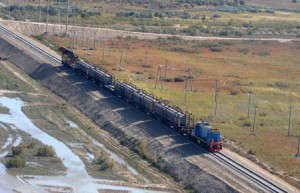 ALMATY REGION – Almaty regional authorities have stepped up efforts to create a favourable investment climate and develop alternative energy.
ALMATY REGION – Almaty regional authorities have stepped up efforts to create a favourable investment climate and develop alternative energy.
Kazakh President Nursultan Nazarbayev’s most recent state-of-the-nation addressed directed the country to increase investments in the economy from 18 to 30 percent of GDP. This is one of the benchmarks for Kazakhstan’s joining the 30 most developed countries of the world. In order to attract private capital, both domestic and foreign, the administration of the Almaty region has worked out a scheme for the development of priority directions until 2020. It provides for the creation of new high-tech industries in the manufacturing sector, agriculture, tourism, construction and the production of pharmaceuticals. The emphasis is on innovative products, increased productivity and the development of industry clusters.
Dairy, fruit and vegetables, poultry, tobacco and wine clusters are planned for the agricultural sphere, and the construction of greenhouses and vegetable storage capacities will be continued. Several clusters were identified for the efficient use of rich tourism resources: an Almaty cluster, a beach and recreation cluster on the coast of the Kapshagai reservoir, clusters at the Balkhash and Alakol lakes and a cluster near the area’s thermal springs and mud spa.
Transit is also a focus. The Kazakhstan 2050 Strategy said that transport infrastructure is the circulatory system of the economy, and it is impossible to break into the top group of advanced countries without quality highways and logistics services.
The proximity of the region to China predetermined the construction of the Zhetigen-Khorgos railway, the Khorgos International Centre of Boundary Cooperation (ICBC Khorgos) and the Khorgos-East Gate Special Economic Zone (SEZ). Thanks to these large-scale projects of the Industrialisation Map, the volume of Kazakh-Chinese cargo transportation has grown and the Panfilov border district is experiencing a construction boom. Altynkol Station, Nurkent Village and modern shopping centres and logistics complexes have recently appeared there.
In the coming years, there are plans to open chemical, steel, food, textile, footwear, building materials and agricultural machinery production complexes in the SEZ. Investors from Turkey, Singapore, South Korea, Japan, the United Arab Emirates and other countries have shown particular interest in the Khorgos dry port.
According to forecasts by international experts, soon the main cargo flow from China to Europe, the Gulf countries, Central Asia and the Caucasus will shift to overland routes. These will include a railway border crossing at Altynkol and the Almaty-Khorgos highway currently under construction and part of the Western Europe-Western China international transport corridor.
Considerable importance is attached to the New Silk Road project, one of the strong points of which is the ICBC Khorgos. This is an important step toward increasing the capacity of Kazakhstan and its emergence as a major trading, logistics and transit hub of Central Asia, as well as a transport bridge between Europe and Asia.
According to local authorities, four industrial zones planned for the Taldykorgan, Kapshagai, Ili and Talgar districts can become other points of economic growth. According to Deputy Akim (Governor) of the region Serik Turdaliyev, about 300 companies will be located on these territories and investment projects will be substantially supported within the State Programme of Accelerated Industrial and Innovative Development (SPAIID), the Business Road Map and the Performance 2020 and Exporter 2020 programmes. Entrepreneurs will receive subsidies for interest rates on loans, compensation for part of production costs and leasing equipment.
In addition, the investors’ service centre under the auspices of the Zhetisu Social and Entrepreneurial Corporation will help businesses create modern productions of export-oriented products. In general, over the past 10 years, the volume of investments in fixed capital has increased eightfold and reached nearly 400 billion tenge (US$2.19 billion) last year.
A programme for renewable energy will be given a special role among Almaty’s priority sectors. A number of large and small hydropower plants with a total capacity of 745 megawatts are already operating in the region. However, large-scale industrialisation, within which dozens of large industrial facilities in recent years were commissioned, led to the growth of electricity consumption. Today, the goal of reducing energy shortages will be achieved through the construction of 15 small hydro stations and wind farms in the Dzhungar Gate District and Shelek Village.
The regional administration has allocated land plots and approved the funding and work schedule. More than 20 domestic companies have expressed a desire to build hydropower, wind and solar farms in Zhetisu, the informal name of the Almaty region meaning “seven rivers”.
The Kainar AKB battery factory in Taldykorgan is going to produce industrial and domestic solar panels and some enterprises have started to manufacture compact mini-plants generating energy from the sun and wind. These products are supplied mainly to residents of remote villages.
The lion’s share of projects are implemented jointly with Samruk-Energo and the Zhetisu SEC. Among them is a wind farm in the Shelek corridor and seven similar facilities in other areas. In addition, a memorandum of cooperation for the construction of a solar power plant of 50 megawatts was signed with a major Egyptian company.
The region’s mountain rivers account for half the country’s volume of hydropower resources. The plan is to increase the power of renewable sources to 919 megawatts. Zhetisu will develop as a green energy zone and some of its processes will be presented at EXPO 2017.

